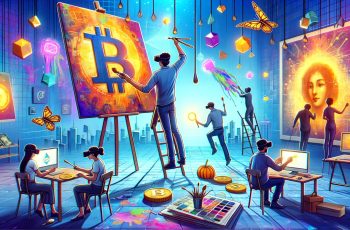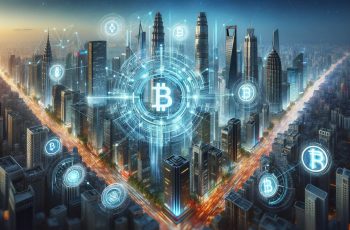Imagine a future where stepping into a virtual world lets you do almost any activity—from gaming and socializing to shopping and joining live events. This is what the metaverse offers—a concept for interconnected virtual spaces that change our digital lives. Not just about new experiences, the metaverse also supports a growing economy with cryptocurrencies and blockchain technology. We explore these exciting business opportunities and new ways of owning and exchanging digital values.
The metaverse economy, powered by cryptocurrencies and blockchain technology, opens exciting opportunities for commerce, owning virtual assets, decentralized finance, and new business models.
What is Metaverse Economy?
At its core, the metaverse economy includes financial activities and value exchanges in virtual worlds. Like the real-world economy, participants in the metaverse can do many economic activities, like:
- Buy and sell virtual goods and services
- Invest in virtual real estate and other digital assets
- Join in play-to-earn games and other rewarding activities
- Use decentralized financial services such as lending and borrowing
The special thing about the metaverse economy is it relies on cryptocurrencies and blockchain infrastructure. Cryptocurrencies like Bitcoin and Ethereum help make exchanges in the metaverse, offering fast, secure, and borderless transactions without usual middlemen. Blockchain technology also makes sure there is trust and transparency needed for virtual economies to work big.
Many blockchain-based platforms are starting immersive 3D worlds showing what the metaverse economy can do. For example, Decentraland is a virtual world owned by users where people can buy, sell, and develop land, create and trade virtual assets, and join various social activities. Similarly, The Sandbox is a gaming metaverse where players can earn from their creations and gaming experiences using the platform’s native cryptocurrency. As more people join these virtual worlds, the chances for commerce and economic activities will keep growing.
Virtual Commerce in the Metaverse
Virtual commerce is a thrilling aspect of the metaverse economy. Similar to how e-commerce transformed shopping in the early internet era, the metaverse has the potential to completely change digital commerce by offering exciting and interactive shopping experiences.
Businesses can choose to create virtual stores and showrooms in the metaverse, allowing customers to see products, use virtual avatars to try them out, and make purchases using cryptocurrencies. This provides brands with fresh opportunities to showcase their products and engage with customers at a deeper level.
A clothing label has the potential to create a virtual pop-up store in the metaverse, featuring interactive exhibits, virtual runway shows, and exclusive digital items. Clients can choose to use virtual avatars to shop at the store, test out clothes, and purchase items that will be sent to either their online wardrobe or home address.
Digital assets are also increasing in popularity in the online world. Decentraland and Cryptovoxels are platforms where users can purchase, trade, and create virtual land, which has sparked the emergence of a fresh digital property market. Currently, there are investors investing millions in valuable virtual properties, taking a risk on the potential future worth of these digital assets.
With the expansion of the metaverse economy, we anticipate an increase in businesses participating in virtual commerce and experimenting with different methods of engaging customers in immersive digital environments.
The Rise of Virtual Assets and NFTs
Virtual assets and non-fungible tokens (NFTs) are major drivers of the metaverse economy. Simply put, virtual assets are digital items valuable within specific virtual worlds or ecosystems, including virtual clothing, weapons, real estate, and even art and collectibles.
NFTs are a special kind of virtual asset verified on a blockchain, which proves ownership and ensures the rarity and uniqueness of digital items. Each NFT is unique and can be bought, sold, and traded like other assets.
Recently, NFTs have become very popular, with some virtual collectibles selling for millions. A famous example is a digital artwork by Beeple sold for $69 million at Christie’s auction. But NFTs do more than digital art; they are starting a new wave of virtual commerce and giving creators new ways to earn from their work.
For example, musicians use NFTs to sell special digital merchandise and experiences to fans. The band Kings of Leon released an album as an NFT with exclusive perks like front-row seats at future concerts. Game developers use NFTs to make rare in-game items that players can collect, trade, and earn money from.
As more creators and brands try NFTs, the market for virtual assets will keep growing and diversifying, creating new revenue streams for creators and new business models in the metaverse economy.
Conclusion
The economy in the metaverse is rapidly changing and offers significant chances for business, exchanging, and creativity. Virtual worlds are finding innovative methods to produce and trade value through the utilization of cryptocurrencies and blockchain technology.
The possibilities for entrepreneurs and investors in the metaverse are diverse and extensive, encompassing virtual property, collectibles, play-to-earn games, and decentralized finance. As we shift more towards digital platforms, the metaverse economy will play a bigger role in our daily routines and job tasks.
Nevertheless, it is essential to address key obstacles like scalability, interoperability, regulation, and user experience in order to fully maximize the opportunities presented by the metaverse economy.
FAQs
In the metaverse, you’ve got your usual suspects like Ethereum and Bitcoin, but platform-specific tokens like MANA (Decentraland) and SAND (The Sandbox) are super trending. They’re basically the fuel for those ecosystems, like gas for your trading engine.
First up, you need to get your digital wallet sorted—think of it as your trading toolkit. Load it with the right crypto, maybe ETH or whatever the platform digs. Then hit up marketplaces like OpenSea—your go-to exchange for virtual land grabs.
Absolutely! We’re talking multi-million-dollar artworks like Beeple’s piece fetching $69 million—crazy, right? Then there’s CryptoPunks and F1 Delta Time cars. It’s like finding a rare gem in a sea of stocks—these NFTs are blue-chip assets in the digital realm.
Imagine turning your store into a 3D virtual experience—customers can try stuff with their avatars. It’s like merchandising in VR, and with blockchain, you create scarcity and authenticity that’s just not possible in traditional markets. It’s leveling up your retail playbook.
Big players are diving into virtual training, remote collabs, and immersive customer engagement—think of it as leveraging decentralized tech to maximize operational alpha. Plus, marketing through virtual events is the new frontier, like hosting a conference in the cloud.




